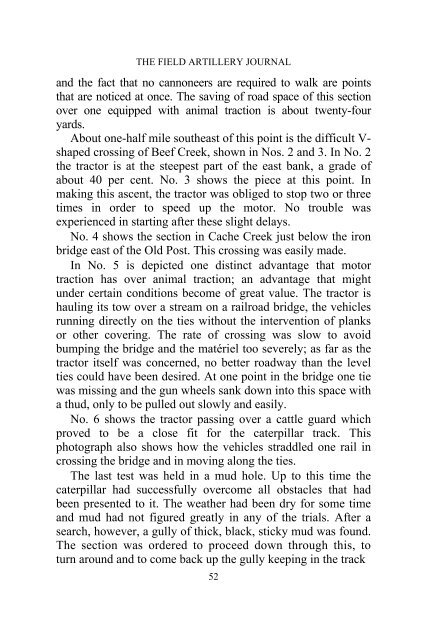the field artillery journal - Fort Sill - U.S. Army
the field artillery journal - Fort Sill - U.S. Army
the field artillery journal - Fort Sill - U.S. Army
You also want an ePaper? Increase the reach of your titles
YUMPU automatically turns print PDFs into web optimized ePapers that Google loves.
THE FIELD ARTILLERY JOURNAL<br />
and <strong>the</strong> fact that no cannoneers are required to walk are points<br />
that are noticed at once. The saving of road space of this section<br />
over one equipped with animal traction is about twenty-four<br />
yards.<br />
About one-half mile sou<strong>the</strong>ast of this point is <strong>the</strong> difficult Vshaped<br />
crossing of Beef Creek, shown in Nos. 2 and 3. In No. 2<br />
<strong>the</strong> tractor is at <strong>the</strong> steepest part of <strong>the</strong> east bank, a grade of<br />
about 40 per cent. No. 3 shows <strong>the</strong> piece at this point. In<br />
making this ascent, <strong>the</strong> tractor was obliged to stop two or three<br />
times in order to speed up <strong>the</strong> motor. No trouble was<br />
experienced in starting after <strong>the</strong>se slight delays.<br />
No. 4 shows <strong>the</strong> section in Cache Creek just below <strong>the</strong> iron<br />
bridge east of <strong>the</strong> Old Post. This crossing was easily made.<br />
In No. 5 is depicted one distinct advantage that motor<br />
traction has over animal traction; an advantage that might<br />
under certain conditions become of great value. The tractor is<br />
hauling its tow over a stream on a railroad bridge, <strong>the</strong> vehicles<br />
running directly on <strong>the</strong> ties without <strong>the</strong> intervention of planks<br />
or o<strong>the</strong>r covering. The rate of crossing was slow to avoid<br />
bumping <strong>the</strong> bridge and <strong>the</strong> matériel too severely; as far as <strong>the</strong><br />
tractor itself was concerned, no better roadway than <strong>the</strong> level<br />
ties could have been desired. At one point in <strong>the</strong> bridge one tie<br />
was missing and <strong>the</strong> gun wheels sank down into this space with<br />
a thud, only to be pulled out slowly and easily.<br />
No. 6 shows <strong>the</strong> tractor passing over a cattle guard which<br />
proved to be a close fit for <strong>the</strong> caterpillar track. This<br />
photograph also shows how <strong>the</strong> vehicles straddled one rail in<br />
crossing <strong>the</strong> bridge and in moving along <strong>the</strong> ties.<br />
The last test was held in a mud hole. Up to this time <strong>the</strong><br />
caterpillar had successfully overcome all obstacles that had<br />
been presented to it. The wea<strong>the</strong>r had been dry for some time<br />
and mud had not figured greatly in any of <strong>the</strong> trials. After a<br />
search, however, a gully of thick, black, sticky mud was found.<br />
The section was ordered to proceed down through this, to<br />
turn around and to come back up <strong>the</strong> gully keeping in <strong>the</strong> track<br />
52

















